Ever wondered how to print on dark or colored clothes? There are actually a few different ways to do it, each with its own pros and cons. While highlighting The two popular options are white toner printing and direct-to-film (DTF) printing. They've both become pretty popular lately, but the main question is which one is the better choice for you? In this article, we'll break down both methods and help you decide which one is the best fit for your needs.
The Similarities Between Them
We're going to be talking about two popular printing techniques: DTF and White Toner Transfer. While they might seem different, they actually share a lot in common.
Both methods involve printing your design onto a special film first, and then we use a heat press to transfer it permanently onto your chosen fabric, like a t-shirt or tote bag. This heat press applies heat and pressure, like a giant panini maker, to make sure the design sticks and stays put.
No matter which method you choose, you'll get amazing results. Both DTF and White Toner Transfer can produce high-quality prints with vibrant colors and sharp details. They're also both versatile, meaning we can use them on a variety of materials, from classic cotton t-shirts to unique canvas tote bags.
Here's a tip for both methods: To make sure your design stays looking great wash after wash, we typically recommend pre-treating the fabric with a special solution. This helps the ink or toner bond to the fabric even better.
Whether you're just starting out or looking for a way to create small batches of personalized items, both DTF and white toner transfer are great options! They're both well-suited for low-volume printing and allow for a lot of creativity.
Remember, no matter which method you choose, using a heat press with the right settings is key. This ensures the design gets the heat and pressure it needs to adhere to properly. Also, don't forget to pre-treat your fabric for the best results!
Both DTF inks and White Toner offer a wide range of colors, so you can create designs that are truly eye-catching. Plus, we can easily customize your project, whether it's a one-of-a-kind gift or a small batch of t-shirts for your team.
Finally, both methods rely on design software to create the artwork we want to print. So, get your creative juices flowing and start designing! Once your design is ready, we'll just need to mirror your designs (depending on the method) and then we can bring your vision to life.
The Difference Between DTF and White Toner Printer
We know that there are many ways to transfer images onto substrates and materials. Today we are going to look at two similar methods that have some differences and they include direct-to-film (DTF) and white toner ink printer transfers.
First, we are talking about DTF printing. It’s a process in which we print an image directly onto a clear film like acetate or DTF pet film using special printers. The film acts as a carrier for the image, which we then place onto the material or substrate, such as fabric or polyester, and then we melt the toner with heat and pressure to adhere to the substrate. We can accomplish this with a heat press or specialized ovens or large-format printers. This process is great as it is compatible with various substrates including cotton, polyester, and blends. The finish is durable, vibrant, and high-quality, making it a popular choice for custom apparel and promotional goods.
Now, we switch to talking about white toner transfers. This is a completely different process that requires different equipment. In this case, we first print the image onto normal paper using a laser printer. We need to use special toner that is translucent and see-through, allowing the color of the substrate to show through where there is no toner. We place the paper face-down on the substrate and then apply heat and pressure to transfer the toner from the paper to the substrate. The translucent toner achieves a more vibrant and high-quality transfer when we use a white substrate. This method allows us to print on more types of materials including dark fabrics.
These are just some methods to customize products, including gifts, promotional items, and apparel.
Which Printing Method is Best for You?
If you're comfortable with tinkering and have a dedicated workspace, I’d suggest that DTF might be a good choice for you because it has a lower initial cost. However, if you prefer a low-maintenance and reliable option with readily available support then I’d suggest that White Toner Transfer (WTT) might be a better fit.
Both technologies are constantly evolving. We can expect softer and stretcher adhesives for WTT and a wider variety of specialized adhesives for DTF in the future. This will offer even more options for different printing needs.

